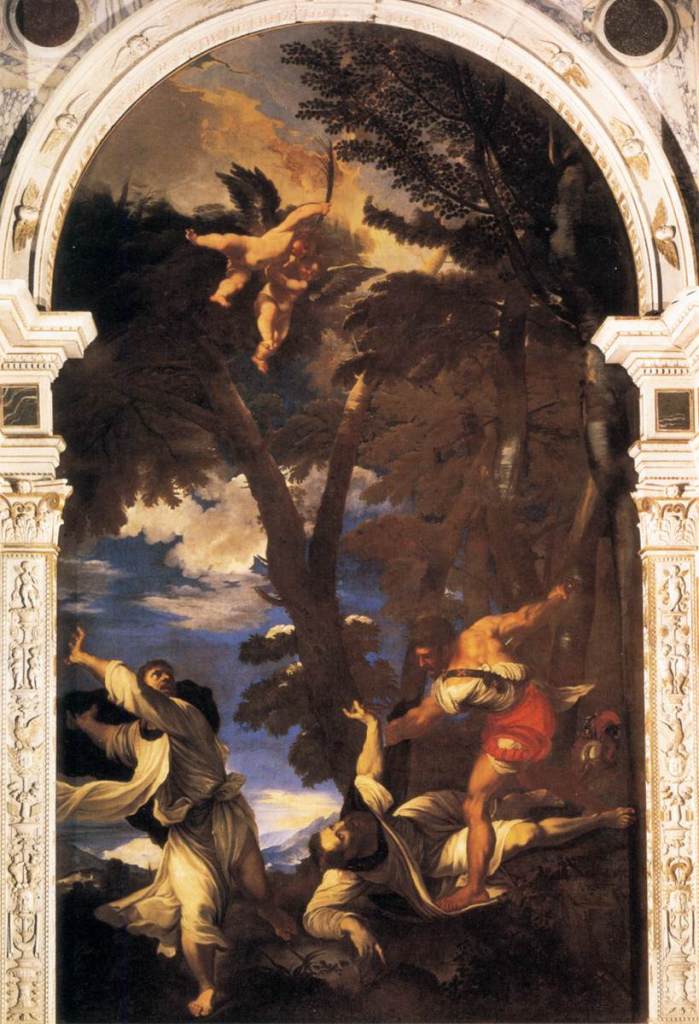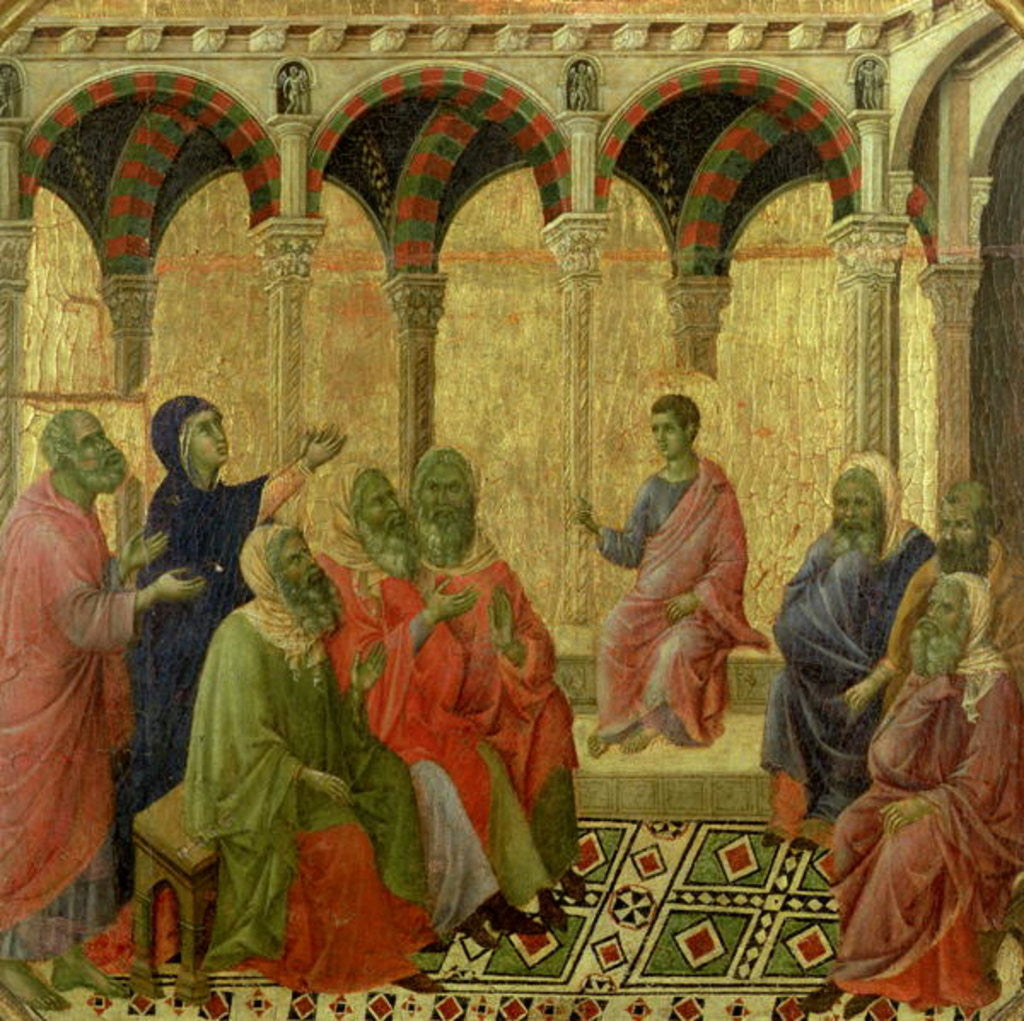In The Penguin Dictionary of Art And Artists, Peter and Linda Murray gave a summary of the meaning of the word CLASSIC. Romantic may be opposed to classic, and yet it may be argued that it departs from the Classic style, only in giving a slightly different emphasis to qualities like colour and movement.
Classic: established excellence
Classicism: A form of art derived (or thought to be derived) form the study of antique exemplars
Neoclassicim: 18thC form encouraged by academies.
Romantic: more emphasis on unbridled expression of the passions, love of the exotic. At its height 1830.
In this usage, classic is often described as being like Apollo (in favour of order) and Dionysus (in favour of wild emotion).
Ingres v. Delacroix
Cubism v. Surrealism
Cezanne went from Delacroix to Poussin.
However Apollo and Dionysus may be considered as two side of the same coin. B. R. Haydon evidently thought that classic art, in the sense of art produced by the greatest of the Greeks, embodied a perfect balance between the demands of Apollo and Dionysus.
So Classical and Romantic both involve schemata which are refined and clearly separated from a precise duplicate of what appears in a viewfinder. They are both examples of the core or grand style.
It may be that painters are naturally drawn to paint in this core or grand style, as best they can (given the contemporary environment and the limits of their own talents and artistic personalities).
Haydon gave some idea of the struggle which artists have made in a quest to achieve this perfection.
Haydon: What Titian, Michael Angelo, and Rafaelle, tried to do, was the habitual practice of the Greeks ; and it is unquestionable it was accident and not intention that kept the Venetians ignorant of form, and accident and not principle which kept the Romans ignorant of colour, for when each school found its error, each school set about remedying its defects.

Titian (1488 – 1575)
destroyed in a fire at Santi Giovanni e Paolo, Venice in 1867
Shown is the 1691 copy by Johann Carl Loth which hangs in place of the original
Vasari’s Lives of the Artists states of it “[the work] is more complete, more celebrated and more great than any other [work] Titian produced in his whole life, the one showing the best understanding and technique”.
Titian, after his return from Rome, set about drawing, as the sight of Titian’s Pietro Martyre will convince all, though Overbeck* told a friend that the Transfiguration was the downfall of the art! and the Pietro Martyre must be set aside, though it is the perfection of art. What wretched sophistry !
*Johann Friedrich Overbeck (1789 – 1869) was a German painter and member of the Nazarene movement.
It may therefore be fairly deduced from the conclusions made, and the reasons laid down for those conclusions, that the Greeks possessed all parts of the art, and none in particular to the exclusion of others ; that therefore all parts of the art in due subordination, may be considered essential to the painter of the highest walks as in the more humble department; that the system which excludes the ideality and power of reality from judicious imitation of the objects painted, combining colour, and light and shadow, as well as expression with form, — is false, and should be exploded from all systems of education in art ; when art is considered a matter of importance to the dignity as well as glory of a great nation.
Here Haydon suggested that the Greeks had excelled at every aspect of the art of painting, all aspects held in perfect balance. This style could simply be called ‘good painting’, except that there are very good paintings which do not hold all parts of the art in perfect balance. For example there are artists today whose styles are superb variations of French Impressionism. Such paintings can be excellent and original, yet lack sufficient emphasis on their schematic basis to bring about the sort of balance that Haydon was describing. Similarly, there are other excellent paintings, made with strong lines (so clearly schematic); and yet which – by the standards of the core or grand style – yet which depart too far from the ‘impressionist’ view. They do not include ‘a judicious imitation of the objects painted’ – as Haydon called it.
This is to assess paintings according to the very highest standards. Painters who do not feel they can aspire to such heights need not be discouraged. As Reynolds pointed out, even to paint an excellent painting in one of the ‘lower departments of art’ is a magnificent achievement.
BERENSON:
his ‘decoration’ is comparable in meaning to the core or grand style
-Bernard Berenson (1865 – 1959) was an American art historian specializing in the Renaissance.-
Reynolds and Haydon were able to write with the authority of practical artists, something which the art historian, Bernard Berenson, was not. Nevertheless some of his thoughts correspond with theirs, and give a useful view of the same subject from a different perspective.
Berenson considered that the art of painting was made up of two components, illustration and decoration – both of which he defined in his own way. To summarise (at the risk of over-simplifying):
Illustration was concerned with translating words and stories into pictures, while Decoration was concerned with the manner of that translation – paying particular attention to qualities of line, form, tone and colour (drawing and design, in other words).
Every culture has its own words and stories to illustrate – so illustration is different in each culture.
In contrast, decoration derives from the visual responses which all people share. (As experimental psychologists have confirmed: disparate cultures share the same ideal of beauty).
The core style might be thought of as being a perfect balance between illustration and decoration – or, in a famous definition: ‘a great painting is an illustration in the form of a decoration’.
Examples of pure decoration, might include, say, a Persian carpet, an abstract painting, or even – at a stretch – a figure by Albert Moore. These may be rewarding to look at, and perfect in their way, but they illustrate little if anything – they do not tell a story.
Similarly, a strip-illustration may function perfectly as an illustration and yet be poor decoratively. But if the artist were gradually to improve the image as decoration (that is, to make it better in drawing and design), it would be moving towards becoming the highest art.
Michelangelo is often thought of as having come closest to the perfect combination: the best illustration combined with the best decoration.
Berenson wrote:
Michelangelo… where he could not perfectly weld Art and Illustration, sacrificed Illustration to Art.
On the Sistine ceiling, Michelangelo’s panels illustrate stories from the old testament, but the The Ignudi hardly illustrate anything. They are little more than young athletes sitting on conveniently placed blocks. Arguably each one illustrates a certain psychological state – though not very clearly. Yet the decorative qualities of form and movement are so powerful that they make these some of the greatest achievements in painting in Western Art.
Berenson concluded by speaking of people who have attempted to explain what they mean by illustration:
Page -127-
The Decorative elements, the intrinsic values, are as perdurable as the psychic processes themselves, which, as we have reason to believe, vary only in degree from age to age, but in kind remain the same through all time. But Illustration changes from epoch to epoch with the contents of the mind, the visual part of which it reproduces, and it is as varied as are races and individuals.

Sienese, c. 1250/1255 – 1318/1319
Christ among the doctors – Sienna
Page -129-53 As an example of illustration, Berenson mentioned a painting by Duccio.
Let us glance at a few of these scenes. In a palace, at the end of two rows of pondering thought-vexed greybeards, sits a majestic boy. On the left a woman and an old man entering lift up their hands in amazement and reproach. Never has the story of ‘Christ among the Doctors’ found a fitter illustration. Not a figure too much; nothing trivial, yet not a touch to lift it beyond human sympathy. Attitude, gesture, and expression can do no more for the theme.
Page -198-
*’tactile values’ refers to the quality given by clearly showing volumes, such as cylinder, sphere and cone. The viewer can imaginatively feel and touch every part of the body that is depicted as if fondling a sculpture. When these volumes are appropriately placed and related, the viewer feels a sense of the body in movement.
For the pursuit of tactile values* and of movement, followed strenuously, and unhampered by the requirements of Illustration, tends to create not only the type of figure but the cast of features known as Classic.
Here Berenson suggested that, as an artist translates the world into schemata, those schemata tend to become ideal – rather as a rough circle tends to become a perfect circle. Similarly other simple shapes and volumes tend to become perfect. For example the cylinder, sphere, cone and so on.
Thus the real world is converted into an ideal world, one made up of geometric concepts, and the process of drawing acts as a kind of idealisation. The more practised the artist becomes, the more complicated the geometrical combinations he or she can develop and retain in the memory.